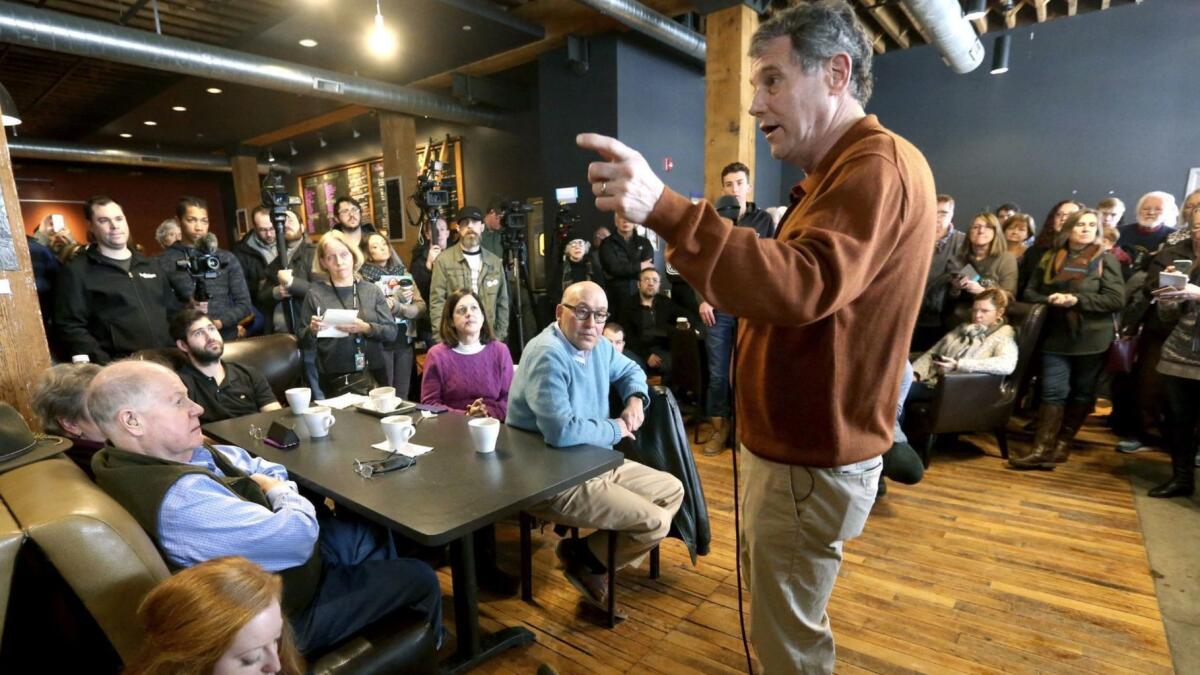Can Democrats win back working-class voters they lost? Sherrod Brown thinks he’s the ticket

- Share via
Reporting from Clinton, Iowa — For Democrats looking to retake the White House, few midterm election results provided a bigger thrill than victories in Wisconsin, Michigan and Pennsylvania — the once-blue states Donald Trump won by excruciatingly narrow margins in 2016, in large part because of support from white, working-class voters.
Enough of those voters came back in 2018 to deliver victory to Democratic governors and U.S. senators across the industrial belt. Now as a big field of 2020 presidential candidates takes shape, Democrats face an urgent question: Who, if anyone, can keep those voters in the fold?
Sherrod Brown of Ohio, a progressive third-term senator with strong ties to organized labor, thinks he may be the answer.
Little known outside his home state, Brown has gained attention while exploring a presidential bid because he sees a void in the field:
“You’ve got to talk to workers,” he said after meeting with union members Saturday in eastern Iowa. “I don’t think anybody’s done that loudly enough, strongly enough and emphatically enough.”
Conducting a three-day tour this weekend through this influential early-voting state, Brown flashed his political badge of honor: In 2018, he was the only Democrat to win statewide in Ohio, holding the support of tens of thousands of Trump voters in a state Hillary Clinton lost by 8 points.
If Brown can win in Ohio, an increasingly conservative state that many Democrats say is all but lost to the party in presidential races, surely he can carry Wisconsin, Michigan and Pennsylvania, he and his backers say.
That pitch found a receptive audience in Iowa.
Tim Powers, a retired firefighter in Waterloo, sees in Brown’s “lunch-bucket” liberalism a possible antidote to Democrats’ 2016 defeat.
“We left the lunch box behind, and we got our ass kicked” in the last election, he said.
Keeping a focus on blue-collar issues is easier said than done when many in the progressive wing of the party are animated by social issues such as LGBTQ rights and immigration policies to the left of the views held by many working-class families.
Noting that a large share of Democrats’ 2018 victories were built on increasing support from upscale, suburban women, Republican pollster Bill McInturff said, “The energy inside the Democratic Party and their issue focus suggests they have moved on from competing for white, working-class voters, especially men.”
But Democratic strategists argue that even if Democrats can’t win back all the voters who moved to Trump in 2016, they can’t give up the fight to hold a share of the white, working-class vote.
“If you look at the chances for Democrats in 2020, one thing they absolutely have to do is take back those states in the upper Midwest,” said Ruy Teixeira, a political analyst at the liberal Center for American Progress. Brown, he said, “is among the best to do that.”
In 2016, Trump won Wisconsin, Michigan and Pennsylvania by fewer than 80,000 votes. That was enough to smash the blue wall of states on which Democrats had relied since 1992.
In those states and elsewhere, Clinton suffered resounding losses among white, working-class voters. Nationwide, she lost them by 39 points — the largest margin for a Democrat going back to 1980 when exit polls first started tracking those voters.
But the midterm results showed Democrats that recovery is possible. In 2018, Democratic candidates in the big industrial states narrowed the gap by half or more compared with Clinton’s deficits, according to exit polls.
To be sure, many of the midterm victories were carried out by well-established incumbents such as Michigan Sen. Debbie Stabenow, and some of the Republican defeats were narrow — Wisconsin GOP Gov. Scott Walker lost by just one point, for example. That’s a reminder to Democrats that winning back the voters they need won’t be easy.
“I would not take them for granted,” said Dayton Mayor Nan Whaley, co-chair of a political committee, Draft Sherrod Brown. “We need to pay very close attention to what we are saying, rather than just assuming everyone will come back home.”
Indeed, Trump allies say they are hopeful that the midterm results in the upper Midwest are not harbingers of a 2020 loss for the president.
“Just as Obama lost the House in 2010 and won reelection in 2012, midterms are poor indicators of future results,” said Brian O. Walsh, president of America First Action, a pro-Trump super PAC. “Whether it’s a liberal senator from Ohio or a progressive senator from California, they’re both part of the problem in Washington, D.C.”
Brown cuts a different profile than many of his potential Democratic rivals from the East and West coasts.
Even in a political era where “authenticity” is highly valued and Sen. Bernie Sanders (I-Vt.) set a low bar for polish, Brown is a standout: His trademarks are unkempt hair, disheveled suits and a gravelly voice.
“He’s the Columbo of the Democratic Party,” said David Axelrod, a Democratic strategist who advised President Obama. “He’d be doing beer commercials if he was a voice-over guy.”
His tour theme is the “dignity of work,” a catchphrase for a populist economic agenda that includes an increased minimum wage, expanded collective bargaining rights, and fighting corporations on behalf of workers.
He is careful to aim his message to workers of all races and types, not just the white working class, as a way to bridge a festering division within the party. “Whether you shower before work or after work, whether you go to work early in the morning or whether you go to work late at night,” is a standard introduction to his litany.
“Too often, people act like our party has to choose between advocating for strong progressive values that excite our base or talking to working-class voters about their lives,” he said when he kicked off his tour Thursday night in Cleveland. “For us, it’s not either-or — it’s both.”
Jeff Horwitt, a Democratic pollster, sees promise for the party in surveys showing that blacks and working-class whites share a sense of dissatisfaction with an economic and political system they see as “stacked against” people like themselves.
“Whomever Democrats nominate in 2020, it will be critical for the nominee to speak the language of the white working class,” Horwitt said. But, he added, “there are an awful lot of ways where the white working class and people of color are looking for the same kinds of change in our country.”
Brown’s tour included many of the kinds of communities Democrats will have to win back in 2020 — counties that voted for Barack Obama in 2008 and 2012 and flipped to Trump in 2016. In Clinton County, where he met with union members Saturday, voters went for Obama with 60% in both elections, but favored Trump by 5 points in 2016.
Like many potential Democratic candidates, Brown is not well known nationally: A December poll by the Des Moines Register found 69% did not know enough about him to have an opinion; 41% said that about California Sen. Kamala Harris; 12% about Massachusetts Sen. Elizabeth Warren.
He’s a lifelong Ohio politician, beginning with his election to the state Legislature in 1974 at age 22. He later served as Ohio secretary of state, in the U.S. House and was elected to the Senate in 2006.
Brown digs deep into the past to establish his progressive bona fides, including his House votes against the Iraq war, the North American Free Trade Agreement and the anti-gay Defense of Marriage Act. (Former Vice President Joe Biden, a potential rival to Brown, voted in favor of all three while in the Senate, Brown’s supporters like to point out.)
His opposition to NAFTA aligned him with Trump and may have helped him win reelection in 2018. While all other statewide Democrats in Ohio lost, Brown won by almost 7 points, although that was a smaller margin than polls projected in a race where he outspent his GOP opponent 7 to 1.
If he runs for president, Brown may face pushback for one notable departure from liberal orthodoxy: He does not support “Medicare for all,” an idea that has moved from the party’s liberal fringes to increasing acceptance, especially among potential 2020 candidates. Brown considers it impractical.
Brown says he supports the idea of universal health coverage and proposes first to allow people in their 50s to voluntarily opt into Medicare. He also would make a public health insurance option available through the Affordable Care Act.
At a meet and greet Friday in Waterloo, Iowa, questioners confronted him on his incremental approach. He responded by calling the broader proposal “tilting at windmills.”
“Everybody feels good saying, ‘I’m for Medicare for all! I’m for Medicare for all!’ but nothing changes,” he said. “I want to change people’s lives and help people now.”
With that, he may have lost a vote. Ruth Walker, a Cedar Falls retiree, said afterward that she was disappointed in his answer and would “probably not” consider backing him. “I’m a real stickler,” she said. “I was not impressed.”
But Brown may also make converts. Dave Donovan, a Sanders supporter who met Brown in Dubuque, has backed Medicare for all but was impressed with Brown’s argument.
“He’s made me think,” Donovan said. “He’s got passion.”
More to Read
Get the L.A. Times Politics newsletter
Deeply reported insights into legislation, politics and policy from Sacramento, Washington and beyond. In your inbox three times per week.
You may occasionally receive promotional content from the Los Angeles Times.











